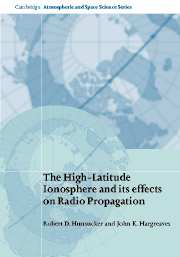Book contents
- Frontmatter
- Contents
- From the Times of London
- Preface
- Chapter 1 Basic principles of the ionosphere
- Chapter 2 Geophysical phenomena influencing the high-latitude ionosphere
- Chapter 3 Fundamentals of terrestrial radio propagation
- Chapter 4 Radio techniques for probing the ionosphere
- Chapter 5 The high-latitude F region and the trough
- Chapter 6 The aurora, the substorm, and the E region
- Chapter 7 The high-latitude D region
- Chapter 8 High-latitude radio propagation: part 1 – fundamentals and early results
- Chapter 9 High-latitude radio propagation: part 2 – modeling, prediction, and mitigation of problem
- Appendix: some books for general reading
- Index
Chapter 8 - High-latitude radio propagation: part 1 – fundamentals and early results
Published online by Cambridge University Press: 02 December 2009
- Frontmatter
- Contents
- From the Times of London
- Preface
- Chapter 1 Basic principles of the ionosphere
- Chapter 2 Geophysical phenomena influencing the high-latitude ionosphere
- Chapter 3 Fundamentals of terrestrial radio propagation
- Chapter 4 Radio techniques for probing the ionosphere
- Chapter 5 The high-latitude F region and the trough
- Chapter 6 The aurora, the substorm, and the E region
- Chapter 7 The high-latitude D region
- Chapter 8 High-latitude radio propagation: part 1 – fundamentals and early results
- Chapter 9 High-latitude radio propagation: part 2 – modeling, prediction, and mitigation of problem
- Appendix: some books for general reading
- Index
Summary
There cannot be a greater mistake than that of looking superciliously upon practical applications of science. The life and soul of science is its practical application
Lord KelvinIntroduction
Propagation of radio waves from ELF to UHF frequencies via the high latitude ionosphere is sometimes radically different from propagation at middle and low latitudes. This is primarily due to the fact that the magnetic field-lines at “corrected geomagnetic latitudes” greater than ∼60° allow solar and magnetospheric particles and plasma to penetrate into the ionosphere. This results in the creation of many large-magnitude irregularities with scale sizes from meters to kilometers, most of which are aligned with the geomagnetic field in the auroral E and F regions. There are also sun-aligned arcs plus patches and blobs of ionization in the polar F region. Because of the extremely wide variation in ionospheric characteristics at high latitudes, this chapter contains many examples of actual propagation behavior.
In contrast, it should also be mentioned that there is a wide spectrum of lessintense ionospheric irregularities in the mid-latitude ionosphere. Since most antennas used for communication and ionospheric sounding up until the 1960s had rather large antenna half-power beamwidths (typically 50° × 50° in azimuth and elevation), these small irregularities were not observed. Starting in the early 1960s, several very-high-resolution HF backscatter sounders were constructed and employed in ionospheric research (see descriptions of the systems and results by Croft, 1968, and Hunsucker, 1991, Ch. 4). These systems revealed a plethora of echoes from irregularities, mostly of meter wavelengths.
- Type
- Chapter
- Information
- Publisher: Cambridge University PressPrint publication year: 2002
- 1
- Cited by



